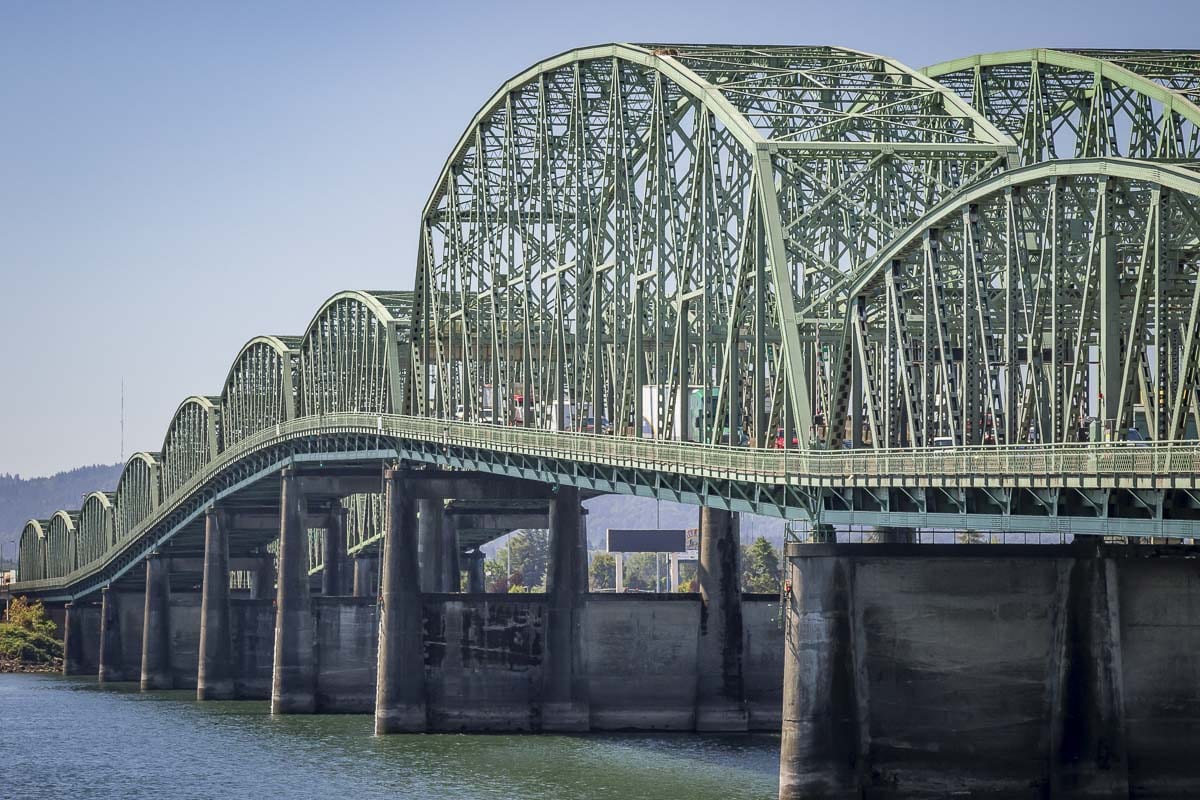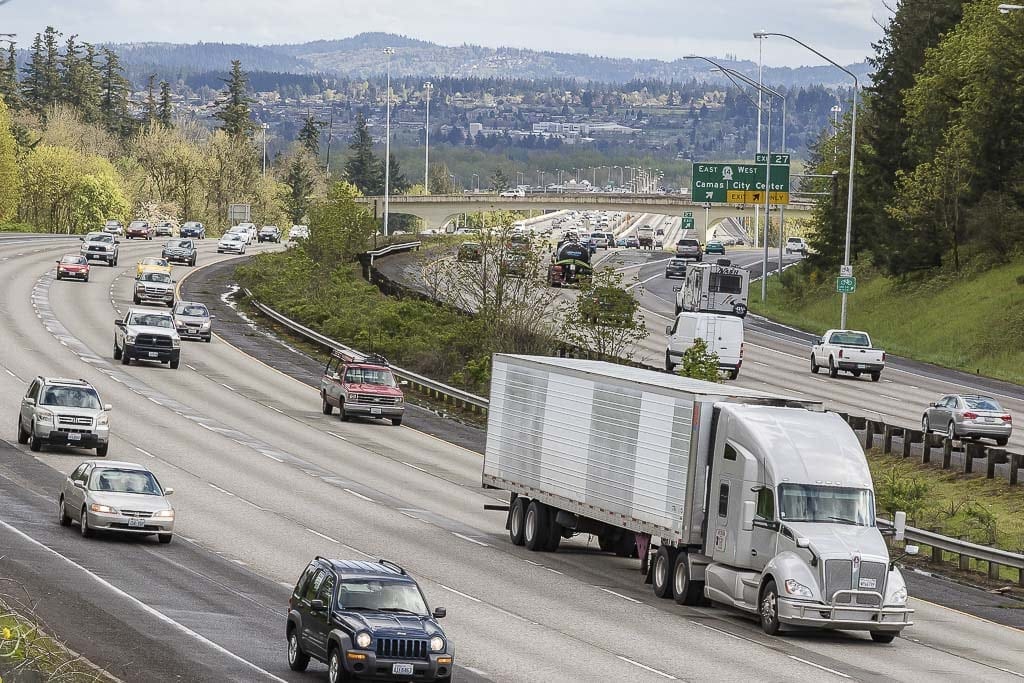Councilor Jeanne Stewart casts the only vote in opposition
VANCOUVER — Members of the Clark County Council passed a resolution Tuesday that supports the replacement of the Interstate 5 Bridge and calls on state officials to provide funds for the project.
The resolution, which the council had worked for several weeks to draft, passed by the vote of 4-1. Councilor Jeanne Stewart cast the only vote in opposition to the resolution. The council’s action comes on the heels of the passage of similar resolutions by the Vancouver City Council and the Port of Vancouver.

Prior to the council’s passage of the resolution, a pair of Clark County citizens expressed opposition to making the replacement of the I-5 Bridge the priority in addressing the traffic congestion issues facing area residents, including the more than 70,000 who commute to Oregon to work each week.
Camas resident John Ley, who has spent countless hours as a citizens’ advocate on the traffic congestion issue, pleaded with the councilors to focus on a new third bridge and the construction of more lanes crossing the Columbia River between Clark County and Oregon.
“The current effort to ‘focus on I-5’ is a thinly veiled attempt to resurrect the CRC,’’ said Ley, referring to the failed Columbia River Crossing project. “The CRC was nothing more than an effort to bring Portland’s financially bankrupt light rail into Vancouver. An Oregon Supreme Court Justice correctly labeled the CRC ‘a light rail project in search of a bridge.’ You should say ‘no’ to this effort.’’
Carol Levanen, a member of Clark County Citizens United, also urged the councilors to consider other alternatives first, before supporting the I-5 bridge replacement.
“On behalf of our membership of over 6,000 folks, we reject the resolution and believe that you should not be be filing this,’’ Levanen said. “The reason is because the people of this county have rejected what has been proposed for that bridge. They have supported a third bridge somewhere. I really think your energies and your information should focus on that and you should be encouraging the state of Oregon and the state of Washington to look at that parameter rather simply one bridge We need other alternatives.’’

“The I-5 freeway is obsolete,’’ Levanen added. “Please don’t encourage the state of Oregon and the state of Washington to look at the same old story that the people have rejected over and over and over again. We need another bridge and please encourage those folks to give us a third bridge rather than spend the money on the I-5 (Bridge).’’
The council’s resolution called the I-5 Bridge “functionally obsolete.’’ The resolution also specifies that the bridge replacement include a lane for Bus Rapid Transit and allows for improvements for bicycle and pedestrian traffic.
Blom takes a lead role in creation of resolution
Councilor John Blom took a leadership role in the construction of the resolution and led the support prior to Tuesday’s vote.
“This resolution lays out some basic principles needed to address congestion, needed to include transit, because this isn’t a bridge for the next five years or the next 10 years,’’ Blom said. “This is a bridge for the next 100 years, so including not just vehicular traffic, but transit traffic, bikes, pedestrians — all the ways that people may want to use that as Clark County grows and moves even further into the 21st century are principles that need to be considered as we move forward on this project.’’
It was clear from Tuesday’s comments that councilors Blom and Julie Olson wanted the resolution to be passed by a unanimous vote. Blom credited Councilor Eileen Quiring for working toward a resolution that addressed concerns about the issue. Despite that, Stewart stood firm on her vote in opposition.
“I’m seriously concerned about the council approving a resolution that was simply a piggy backing off a resolution developed and put through by the Vancouver City Council,’’ Stewart said. “Vancouver is a very important city in Clark County, certainly our largest city, they have a big voice, but it’s really unfortunate that the county body has not taken a leadership role in thinking about the future of Clark County.
“Replacing a bridge, as it’s designed right now, if they resurrect the Columbia River Crossing plan does not add capacity,’’ said Stewart, who previously served on the Vancouver City Council. “Approving this resolution, and there are the votes to do that here, does not look to the long-term future. It’s not even a bandaid. It does not look to the long-term economic development growth and health of Clark County.’’
Stewart also voiced her concerns about what an I-5 Bridge replacement project will do to the area’s traffic congestion issues.
“In the meantime, we will have misery,’’ Stewart said on the construction period. “This is an inadequate solution to the problem and the whole time this is going on there is no promise we will be looking for a third crossing. It’s woefully inadequate.’’
Quiring compromises despite big picture view
Despite her vote in favor of the resolution, Quiring said she still favors the construction of another bridge prior to the I-5 Bridge replacement.
“What I would rather have to begin with is another bridge,’’ Quiring said. “I would like to have one or two more bridges. I think we should be working on that. The problems we’ve had with this bridge (project) makes me think that’s almost an impossible task to begin with another bridge at this point.’’
Quiring also said she disagreed with the fact that the resolution states that the I-5 Bridge is “functionally obsolete.’’
“I do not agree that it’s functionally obsolete,’’ Quiring said. “It does have seismic problems, but I’ve been told those seismic problems can actually be addressed underwater to improve the stability of this bridge.’’
Quiring also said she fought for language to be included in the resolution that opposed tolling. She did get language included that pushed for a “fiscally responsible bridge replacement that considers the financial impact to working families of Clark County.’’
“That phrase is as close as we could get to an agreement on no tolls,’’ Quiring said. “That Section 3 is my way of saying ‘no tolls’ to fund this bridge. I don’t want tolls.’’
High capacity transit and dedicated right of way
Both Blom and Quiring said the inclusion of language in the resolution for high capacity transit and dedicated right of way was necessary for the project to qualify for federal funding.
“Some of the things are bound by federal dollars in terms of what a project looks like,’’ Blom said. “If someone has a better way to come up with a billion dollars toward the project, I would love to hear it but right now, the way the grants are structured, high capacity transit and dedicated right of way is one of the requirements.’’
“We do make a statement in this that we prefer C-TRAN and Bus Rapid Transit,’’ Quiring said. “We have created the infrastructure for that, so we ought to be using it. We should not waste what we already have.’’
In his comments, Ley dispelled the idea that Bus Rapid Transit is an adequate use of funds in this project.
“We presently have 300,000 daily crossings of the Columbia River via our two bridges,’’ Ley said. “Yet, C-TRAN’s ‘express’ bus service carries only 1,500 people to downtown Portland on an average day. That’s one half of 1 percent. Light rail serves just under 1 percent of daily trips, according to John Charles of the Cascade Policy Institute.
“Yet, our own RTC (Southwest Washington Regional Transportation Council) has a light rail extension to Vancouver in their 2035 plan. Portland Metro’s JPACT (Joint Policy Advisory Committee on Transportation) has a light rail extension and a new bridge in their 2040 plan,’’ Ley said. “Furthermore, Metro’s plan shows $3.17 billion for a new replacement Interstate bridge; $850 million for a light rail extension, and $80 million for a new bridge from the Expo Center to Hayden Island. That’s $4.1 billion. And, of course, they expect southwest Washington citizens to help pay for all this via tolls.
“One portion of your resolution deals with ‘dedicated lanes’ for transit,’’ Ley told the councilors. “Again, C-TRAN’s mass transit serves less than 1 percent of the daily crossings. The number of people riding our express buses has been declining for at least half a decade. WSDOT (Washington Department of Transportation) told the RTC last month that a highway lane carries 1,800–2,400 vehicles an hour. If our current C-TRAN had five separate lines into Portland operated at 15-minute intervals, you would have at most 100 vehicles per hour on that dedicated lane. But, you would be preventing another 1,700–2,300 vehicles from using that lane if it were a general purpose lane. A dedicated lane doesn’t solve the problem.’’
Despite vote, Olson pushes for identification of new corridors
Councilor Julie Olson said that despite her vote to approve the resolution, she also supported the exploration of building new corridors.
“Just because we support this resolution doesn’t mean that we don’t support additional crossings,’’ Olson said. “We should be working with our Planning Department to identify additional corridors.’’
Stewart asked for a commitment by the other councilors to do just that.
“Can we get council to commit to that?’’ Stewart asked, receiving no response. Stewart added that “we are not building any residual capacity (with the I-5 Bridge replacement). It will be at capacity the minute the gates are open.’’
Council chair pointed out that the Glenn L. Jackson Memorial Bridge (over I-205), completed in Dec. 1982, was the cumulation of planning that began in 1959, when property was being acquired in anticipation of the project.
“If 205 was on the map in 1959, I think it’s time we get something on the map for the future,’’ Quiring said.




